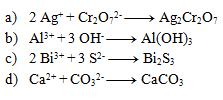Ionic equations
Ion is an atom or a molecule with a nonzero charge, meaning the total number of its electrons does not equal the number of its protons. The tendency to form ions depends on the electronegativity of each element. If the number of electrons exceeds the number of protons, the atom or molecule is negatively charged. Such a particle is called an anion. If the number of protons exceeds the number of electrons, the particle is positively charged and we call it a cation.
Ions are distinguished as monoatomic (Na+, Cl-, Cu2+, Ir3+…), molecular (OH-, CO32-, HS-…) and complex ([Fe(CN)6]4-, [Cu(H2O)6]2+, [Cu(H2O)2(NH3)4]2+, [HgI4]2-…)
Ionic equations are chemical equations that describe reactions of ions in aqueous solutions of acids, bases, and salts. For these reactions to take place, at least one of the following conditions must be met:
- A precipitate (insoluble substance) is formed
- A weak electrolyte is formed
- A gas is formed
- The oxidation number of atoms changes
We write weak electrolytes (NH4OH, H2S, HCN, H2O…), gases (CO2, SO2, SO3, NH3, Cl2, NO…) and precipitates (AgBr, CaCO3, AgCl, PbI2…) as whole molecules.
1. Write the given chemical equation in ionic form:
Solution:
We can write as ions only formulas of strong acids, bases, and salts well soluble in water. Other substances are not dissociated:

2.
Write the ionic equation of the precipitation reaction of sulfuric acid with barium chloride.
Solution:
First, we write the equation in stoichiometric form:

Next, we write the dissociations:

Final equation:

3.
The following equations are precipitation reactions. Write them in ionic form:
Solution:

4.
The following equations represent complex formation reactions. Write them in ionic form:
Solution:

5.
Balance the following ionic equations. Pay attention not only to the sum of atoms but also to the sum of charges on both sides.
Solution:
- a) 1,2,1,6,4
- b) 1,1,2,1,1
- c) 2,1,4,1,1,2
- d) 1,1,1,1,2
- e) 2,1,4,1,1,2
- f) 3,2,1,2
- g) 1,1,2,1,1,1
6. Write the ionic equation and the net ionic equation of the reaction of sodium chloride with silver nitrate.
Solution:
First, we write and balance the stoichiometric equation:
AgNO3 + NaCl → AgCl↓ + NaNO3
Next, we write all compounds in ionic form, except for the precipitate:
Ag+ + NO3- + Na+ + Cl- → AgCl↓ + Na+ + NO3-
If we omit ions that appear on both sides of the equation (spectator ions), we get the net ionic equation:
Ag+ + Cl- → AgCl↓
7. Determine the stoichiometric coefficients in the following chemical equation:
[SnCl3]– + H2O → [Sn3(OH)4]2+ + H3O+ + Cl–
Solution:
In this chemical equation, the oxidation numbers of all atoms do not change, so it is not a redox reaction. We select the compound with the largest stoichiometric indices and assume its coefficient is 1; in this case, the product [Sn3(OH)4]2+. On the right side, there are three tin atoms, so we place coefficient 3 in front of [SnCl3]–:
3[SnCl3]– + H2O → [Sn3(OH)4]2+ + H3O+ + Cl–
On the left side, this gives 9 chlorine atoms, so we place coefficient 9 in front of Cl–:
3[SnCl3]– + H2O → [Sn3(OH)4]2+ + H3O+ + 9Cl–
We still need to determine the coefficients for water and hydronium ion. Using charge balance: left side = –3, right side (excluding H3O+) = –7. Therefore, the coefficient of H3O+ must be 4 to balance charges:
3[SnCl3]– + H2O → [Sn3(OH)4]2+ + 4H3O+ + 9Cl–
On the right side, there are 16 hydrogen atoms, so the coefficient for H2O must be 8:
3[SnCl3]– + 8H2O → [Sn3(OH)4]2+ + 4H3O+ + 9Cl–
8. The reaction of barium chloride with magnesium sulfate produces a precipitate of barium sulfate. Write the net ionic equation of this process.
Solution:
First, write the full chemical equation:
BaCl2 + MgSO4 → BaSO4 + MgCl2
Since the reaction occurs in solution, it involves freely moving ions. BaSO4 is a precipitate, poorly soluble in water, so we do not write it as ions:
Ba2+ + 2Cl- + Mg2+ + SO42- → BaSO4↓ + Mg2+ + 2Cl-
After omitting spectator ions, we obtain the net ionic equation:
Ba2+ + SO42- → BaSO4↓
9. Dissolving calcium phosphate precipitate using nitric acid can be written as:
Ca3(PO4)2↓ + 6HNO3 → 3Ca(NO3)2 + 2H3PO4
Write the ionic and net ionic equations for this reaction.
Solution:
Ionic equation:
Ca3(PO4)2↓ + 6H+ + 6NO3- → 3Ca2+ + 6NO3- + 6H+ + 2PO42-
Net ionic equation:
Ca3(PO4)2↓ → 3Ca2+ + 2PO42- or Ca3(PO4)2↓ + 6H+ → 3Ca2+ + 2H3PO4
10. Write the ionic equation of the reaction of sodium hydroxide with sulfuric acid.
Solution:
First, write and balance the complete chemical equation:
H2SO4 + 2NaOH → Na2SO4 + 2H2O
Both reactants are fully dissociated in solution. Sodium sulfate is also soluble. Water is considered a weak electrolyte, so we do not dissociate it:
2H+ + SO42- + 2Na+ + 2OH- → 2Na+ + SO42- + 2H2O
This neutralization can be written in the general form of any neutralization:
H+ + OH- → H2O
11. Balance the following ionic reactions and make sure to preserve the overall charge of reactants and products, not just stoichiometry:
P3- + H2O → PH3 + OH-
Au3+ + Cl- → [AuCl4]-
As2S3 + OH- → AsO2- + AsS2- + H2O
[Cu(H2O)6]2+ + Cl- → [CuCl4]2- + H2O
VO43- + H+ → V3O93- + H2O
CrCl2O2 + OH- → CrO42- + Cl- + H2O
HPO42- + MoO42- + H+ → [P(Mo3O10)4]3- + H2O
[Al(H2O)4(OH)2]+ + CO32- → [Al(H2O)3(OH)3] + HCO3-
Solution:
P3- + 3H2O → PH3 + 3OH-
Au3+ + 4Cl- → [AuCl4]-
2As2S3 + 4OH- → AsO2- + 3AsS2- + 2H2O
[Cu(H2O)6]2+ + 4Cl- → [CuCl4]2- + 6H2O
3VO43- + 6H+ → V3O93- + 3H2O
CrCl2O2 + 4OH- → CrO42- + 2Cl- + 2H2O
HPO42- + 12MoO42- + 23H+ → [P(Mo3O10)4]3- + 12H2O
[Al(H2O)4(OH)2]+ + CO32- → [Al(H2O)3(OH)3] + HCO3-